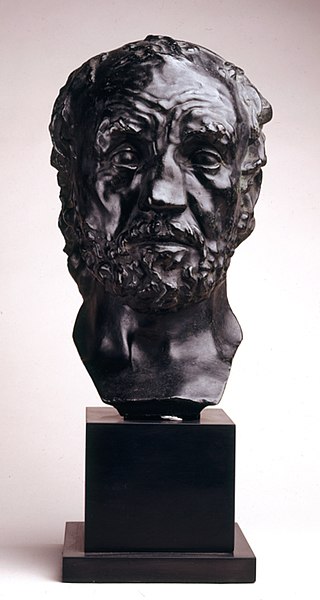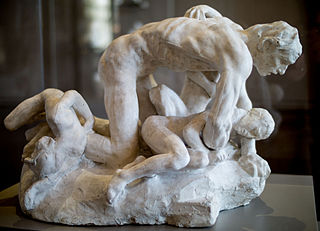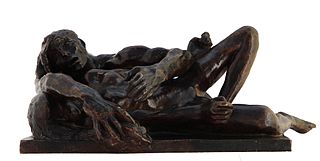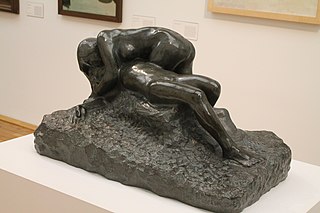
The Gates of Hell is a monumental bronze sculptural group work by French artist Auguste Rodin that depicts a scene from the Inferno, the first section of Dante Alighieri's Divine Comedy. It stands at 6 metres high, 4 metres wide and 1 metre deep (19.7×13.1×3.3 ft) and contains 180 figures.

The Museo Soumaya is a private museum in Mexico City and a non-profit cultural institution with two museum buildings in Mexico City — Plaza Carso and Plaza Loreto. It has over 66,000 works from 30 centuries of art including sculptures from Pre-Hispanic Mesoamerica, 19th- and 20th-century Mexican art and an extensive repertoire of works by European old masters and masters of modern western art such as Auguste Rodin, Salvador Dalí, Bartolomé Esteban Murillo and Tintoretto. It is called one of the most complete collections of its kind.

The Alsatian Orphan / L'Orpheline Alsacienne is a sculpture made by the French artist Auguste Rodin (1840-1917). In the beginning of his career, Rodin made decorative pieces. This piece was created during this phase.

Man with the Broken Nose is a sculpture by Auguste Rodin created between 1863 and 1864 and approved by the Salon in 1875. It is considered the first by Rodin in which life is represented over the grace pervading the academic circles and aesthetic of the time.

Pierre de Wissant is a bronze sculpture by French artist Auguste Rodin, part of his sculptural group The Burghers of Calais. This sculpture represents one of the six burghers who, according to Jean Froissart surrendered themselves in 1347, at the beginning of the Hundred Years' War (1337–1453), in order to save the inhabitants of the French city of Calais from the English laying siege to the city.

Ugolino and his sons is a plaster sculpture by French artist Auguste Rodin, part of the sculptural group known as The Gates of Hell. As an independent piece, it was exhibited by its author in Brussels (1887), Edinburgh (1893), Genoa (1896), Florence (1897), Netherlands (1899) and in his own retrospective in 1900.

Avarice and Lust is a sculpture by French artist Auguste Rodin, conceived between 1885 and 1887, representing two of the seven capital sins and is part of his sculptural group The Gates of Hell, where it can be found in the lower part of the right door. It's possible that the name was inspired by Victor Hugo's poem Après une lecture du Dante:

Head of Camille Claudel is a polychrome glass paste sculpture by the French artist Auguste Rodin, conceived in 1884 and executed in 1911. It is now in the Museo Soumaya in Mexico City. It shows his then studio assistant Camille Claudel in a Phrygian cap.

Danaid is a sculpture by Auguste Rodin, based on the account in the Metamorphoses of Hypermnestra, eldest of the Danaïdes.

Eve is a nude sculpture by the French artist Auguste Rodin. It shows Eve despairing after the Fall.

The Three Shades is a sculptural group produced in plaster by Auguste Rodin in 1886 for his The Gates of Hell. He made several individual studies for the Shades before finally deciding to put them together as three identical figures gathered around a central point. The heads hang low so that the neck and shoulders form an almost-horizontal plane. They were to be placed above the gates looking down on the viewer.

The Athlete is a 1901-1904 black-patina bronze sculpture by the French artist Auguste Rodin It measures 39,4 × 27,5 × 24,3 cm.

The Maiden Kissed by the Ghost is an 1880 sculpture by the French artist Auguste Rodin. It was first exhibited at his fourteenth exhibition, hosted by the National Society Salon. One of the marble versions of the work is now in the Museo Soumaya in Mexico City.

The Kneeling Man is a work originally conceived in 1888 by the French artist Auguste Rodin for his The Gates of Hell project.

Youth Triumphant is one of the sculptures created by Auguste Rodin as part of the planning for his The Gates of Hell. It was inspired by Jean Dampt's The Grandmother's Kiss, exhibited in 1893. That work shows a young woman resting in the arms of an old woman, with the pair deeply kissing.

The Death of Adonis is a white marble sculpture. It was created by Auguste Rodin and signed “A RODIN” on the base. It shows Aphrodite mourning over the body of Adonis. The main version is in the Musée Rodin and another is in the Museo Soumaya.

The Shade, The Slave or The Titan is a sculpture by the French artist Auguste Rodin.

Suzon is an early bust of a woman by Auguste Rodin, created between 1872 and 1873 when he wholly worked on commissions. It was inspired by late 18th century Romantic works whilst Rodin was in exile in Brussels due to the Franco-Prussian War. He created it in homage to Albert-Ernest Carrier-Belleuse, another sculptor also in exile there who was highly influential on Rodin's early works.

Torso of Adele is an 1878-1884 sculpture by the French artist Auguste Rodin, originally modelled in plaster before being worked in terracotta.



















